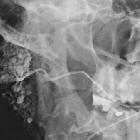Sjogren syndrome








Sjögren syndrome, or Sjögren disease, is an autoimmune condition of the exocrine glands that produce tears and saliva.
Epidemiology
Sjögren syndrome is the second most common autoimmune disorder after rheumatoid arthritis. There is a recognized female predilection with F:M ratio of ≈9:1. Patients typically present around the 4to 5 decades.
Clinical presentation
Clinically, the cardinal features are glandular:
- keratoconjunctivitis sicca (xerophthalmia)
- dryness of the mucous membrane of the mouth (xerostomia)
- bilateral parotid enlargement
Additionally, there may be multi-organ extra-glandular involvement, which can have a wide variety of clinical features.
Pathology
It is a chronic autoimmune disorder involving mainly the salivary and lacrimal glands and is associated with hyperactivity of the B-lymphocytes and with autoantibody and immune complex production.
Associations
Approximately 40% of cases occur in isolation. Known associations include:
- thoracic changes associated with Sjögren syndrome
- non-specific interstitial pneumonitis (NSIP): considered the most common pattern
- usual interstitial pneumonitis
- lymphoid interstitial pneumonia (LIP)
- focal lymphoid hyperplasia of the lung
- small airways disease
- pulmonary amyloidosis: AL type
- Mikulicz syndrome (sometimes known as Sjögren type 1 )
- other connective tissue diseases
- EBV infection
- Hepatitis C infection
- primary biliary cirrhosis (possible )
- HTLV infection
Markers
- anti-Ro (SSA) antibody
- anti-La (SSB) antibody
Radiographic features
Ultrasound
Salivary glands
- early stage: the gland can be normal or become enlarged and hyperechoic
- late stages: may characteristically show a multicystic or reticular pattern within an atrophic gland
MRI
Salivary glands
Parotid gland involvement may give a salt and pepper appearance or a honeycomb appearance. A change in the size of the lacrimal glands associated with accelerated fat deposition may also be seen .
Treatment and prognosis
Complications
One of the complications of this syndrome is the development of malignant lymphoma.
History and etymology
This condition is named after Swedish ophthalmologist Henrik Sjögren (1899-1986) although it was first described by WB Hadden and JW Hutchinson in 1871 .
Siehe auch:
- Milchglasverschattungen
- verdickte interlobuläre Septen
- Sialographie
- subpleurale Zysten
- Tumoren der Tränendrüse
- Usher-Syndrom
- Marinescu-Sjögren-Syndrom
- Sicca-Syndrome
- pulmonale Manifestation bei Sjögren-Syndrom
- kindliche Sialektasie
und weiter:
- Warthin-Tumor
- multiple zystische Lungenherde
- Amyloidose
- Sialadenitis
- tree in bud-Muster
- lymphozytisch interstitielle Pneumonie
- Interstitielle Lungenerkrankung
- interstitial pneumonia
- Amyloidose der Lunge
- bilaterale axilläre Lymphadenopathie
- zystische Läsionen der Glandula parotis
- Pneumonitis
- small fiber neuropathy
- bronchus associated lymphoid tissue lymphoma
- Rheuma Differentialdiagnose
- differential diagnosis of intramuscular high STIR signal on MRI
- Muskelödem
- echogenic renal pyramids
- adenoid cystic carcinoma of lacrimal glands
- Xerostomie
- Vergrößerung der Glandula parotis
- panda sign of sarcoidosis
- follikuläre Bronchiolitis
- pulmonale noduläre lymphoide Hyperplasie
- Verkalkungen Glandula parotis
- sjögren syndrome associated with systemic lupus erythematosus
- Sjogren's syndrome in scleroderma
- MR sialography in Sjogren's syndrome
- Pfeffer und Salz Erscheinungsbild
- Sjörgen Syndrom hand
- MRI of the parotid glands in a patient with Sjogren's syndrome
- benigne lymphoepitheliale Läsionen
- SLE-Sjögren overlap syndrome
- pulmonale hyaline Granulomatose

 Assoziationen und Differentialdiagnosen zu Sjögren-Syndrom:
Assoziationen und Differentialdiagnosen zu Sjögren-Syndrom:




